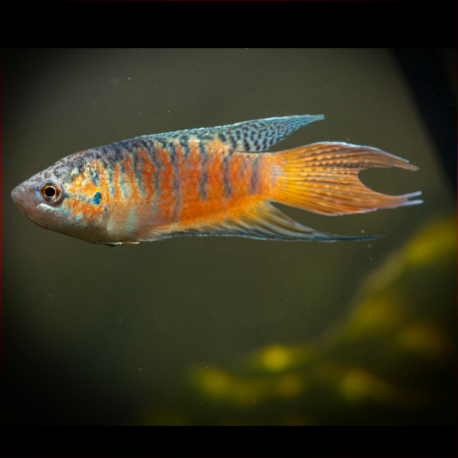Macropodus Opercularis
Perciformes Print
More info
Datasheet
| Minimum Tank Size | 72 litres / 19.02 US gallons |
| Maximum Size | 8.0cm / 3.15inches |
| Temperature | 10°C / 50.00°F - 22°C / 71.60°F |
| Hardness | 5.04dgH / 90ppm - 20.00dgH / 357ppm |
| pH | 6.0-8.0 |
General Description: Macropodus Opercularis, commonly known as Paradise Fish, is a classic aquarium inhabitant with a historical introduction to the hobby dating back to 1869. This species, with distinct characteristics such as a forked caudal fin and blue body bars on a red background, belongs to the family Osphronemidae in the classification order Perciformes.
Aquarium Setup: For optimal care of M. opercularis, a tank of at least 72 liters is recommended, with suitable decorations like driftwood, roots, and floating vegetation. Although substrate is optional, dried leaf litter can offer cover and food sources for the fish. The species can thrive in unheated tanks, benefiting from a cool period during winter months (see table for water condition details).
Behaviour: Paradise Fish can display territorial aggression, especially during reproductive periods. It is advised to avoid keeping similarly-shaped fishes together and provide ample space if housing multiple males. Females should outnumber males to disperse aggression effectively.
Feeding and Diet: In nature, M. opercularis preys on insect larvae and similar prey. In captivity, they thrive on a diet of small live or frozen foods like Daphnia, Artemia, and worms. Commercial strains may also accept high-quality dried products as part of their diet.
Reproduction & Dimorphism: This species is a bubble nester, exhibiting unique reproductive behaviors. Soft water and slightly raised temperatures can induce spawning, with males building nests for females. Males are larger with extended soft rays in their fins, while females may appear paler during spawning.
Habitat and Distribution: Macropodus Opercularis is adaptable to various lowland habitats, including streams, ponds, rice paddies, and artificial reservoirs. Its natural distribution spans regions in China, Vietnam, Laos, Taiwan, and Hainan Island, with introduced populations in countries like South Korea, Japan, and the United States.

